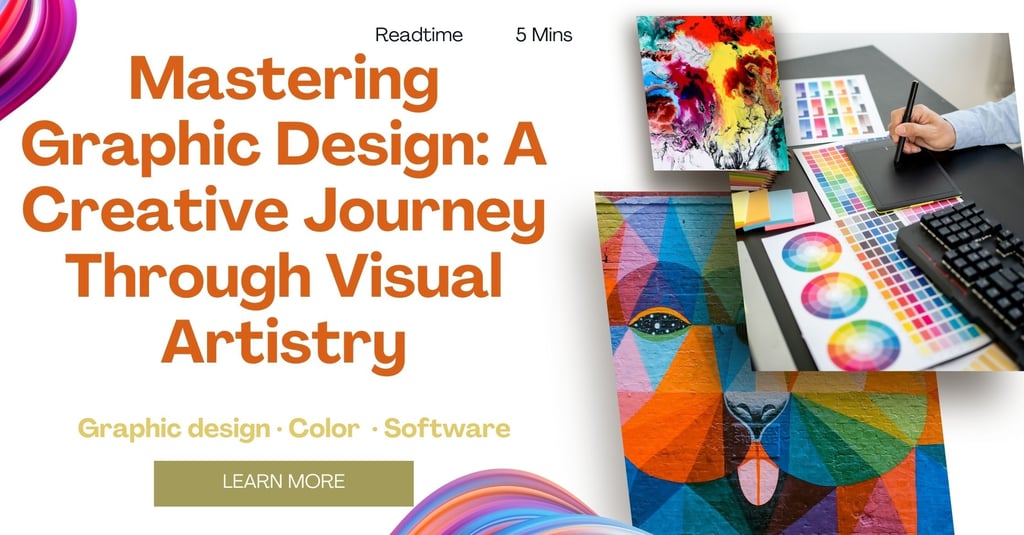Mastering Graphic Design: A Creative Journey Through Visual Artistry
Graphic design Visual art Creative design Visual storytelling Color theory Typography Composition Graphic design trends Visual communication Design software
LATEST
10/20/20233 min read


Graphic design is a captivating field that combines creativity and technology to convey powerful messages through visual elements. In a world driven by visuals, it has become a fundamental part of communication for both businesses and individuals. Whether you are a design enthusiast or a professional looking to enhance your skills, this blog explores the key aspects of graphic design, offers guidance on creating stunning visual content, and delves into how it can positively impact businesses.
The Art of Graphic Design
Graphic design is more than just aesthetics; it is about problem-solving and storytelling. Let's delve into the fundamental concepts that make this discipline so captivating.
Visual Artistry: Graphic design is essentially the art of creating visually appealing and engaging content. It encompasses various design elements, such as shapes, colors, imagery, and layout. For example, consider a well-designed logo for a business; it should visually represent the essence of the brand and make a lasting impression on customers.
Creative Design Process: The process of graphic design is inherently creative. It often begins with brainstorming, sketching, and conceptualizing ideas to bring a unique vision to life. For instance, when designing marketing materials, a graphic designer might create multiple drafts and concepts before finalizing a design that effectively communicates the brand's message.
Color Theory: Color theory is at the heart of graphic design. Understanding the psychology and meanings behind colors is essential for creating visually appealing and impactful designs. For example, using specific colors can evoke emotions or create associations, like using blue to convey trust and reliability in a corporate brochure.
Typography: Typography, the art of arranging type, plays a significant role in graphic design. The choice of fonts and how text is laid out can greatly impact the readability and aesthetics of a design. Think of a website's user interface design where the choice of fonts and text alignment influences how users engage with the content.
Composition: Composition deals with how different design elements are arranged within a design. A well-structured composition guides the viewer's eye and creates balance and harmony. For instance, a poster for a music festival may use composition to ensure that the event details are clear and that the visuals reflect the festival's atmosphere.
Staying Current with Trends
Graphic design is a dynamic field that constantly evolves. Staying up-to-date with the latest trends is essential for creating modern and relevant designs.
Adaptive Design: In a mobile-centric world, designing for various screen sizes and orientations is crucial. Responsive web design is a prime example of adapting to different devices to ensure a seamless user experience. For businesses, this means ensuring their websites and marketing materials are accessible and functional on all devices, boosting user engagement and retention.
Minimalism: The "less is more" approach remains a prominent design trend. Clean, simple, and minimalistic designs are often highly effective in conveying a message or brand identity. Iconic brands like Apple exemplify minimalistic design, which not only boosts brand recognition but also conveys a sense of sophistication and clarity.
Bold Typography: Using bold and expressive typography as the focal point of a design is a trend that has gained significant traction. A striking example is the use of bold typography in advertising campaigns to create a memorable and impactful message that resonates with the audience.
Sustainability and Eco-Friendly Design: Many businesses are incorporating eco-friendly and sustainable design practices to showcase their commitment to the environment. For instance, a sustainable product packaging design might feature recyclable materials and environmentally conscious messaging. This not only appeals to eco-conscious consumers but also helps businesses align with their corporate social responsibility goals, potentially boosting their reputation and sales.
Tools of the Trade
Graphic designers rely on various software and tools to bring their ideas to life.
Design Software:
Design software is the backbone of graphic design, and Adobe Creative Cloud (e.g., Photoshop, Illustrator, InDesign) is a popular choice for professional graphic designers. These tools allow designers to create, edit, and manipulate visuals with precision. They are essential for businesses because they enable them to produce professional marketing materials, maintain brand consistency, and convey their messages effectively.
Online Resources:
Stock photo websites, design forums, and tutorials are invaluable resources for designers. These platforms provide inspiration and assets for your projects. Businesses can leverage these resources to access high-quality images and design inspiration, which can enhance the quality of their marketing materials, attract customers, and drive conversions.
Conclusion
Graphic design is a dynamic and versatile field that plays a crucial role in communication and branding for businesses. Whether you are creating a brand identity, designing a website, or crafting social media content, the principles of graphic design are fundamental. Embracing creativity, mastering design software, and staying updated with the latest trends will help you excel in the world of visual artistry. Your journey in graphic design will be one where every pixel and brushstroke tells a unique and compelling story, ultimately benefiting businesses by enhancing their brand recognition, customer engagement, and message conveyance.


CONTACT US
+91 9390778921
digionlion@gmail.com
info@digitalonlion.com
ARG Complex, Badangpet, Balapur, Hyderabad, Telangana, India, 500058
OnLion is a Hyderabad-based digital marketing agency helping startups and businesses grow with smart SEO, web design, and social media strategies. Get results that matter , partner with us today.